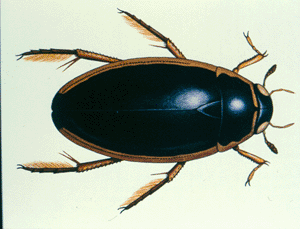
ADAPTATIONS
Identifying characteristics for the
predaceous diving beetle include...
-
Distinctively shaped body- elongated and oval
- Hind legs flattened and fringed for increased speed when swimming and diving. The hind legs are flattened like paddles and have stiff hairs that increase the surface area for better propulsion.
-
They possess threadlike antennae
- Adults utilize air trapped under a structure called the elytra to stay submerged for long periods of time.
-
Use a "frog kick" with their back legs for swimming
- Beetles are generally characterized by a particularly hard exoskeleton, and the hard wing-cases which tend to cover the hind part of the body and protect the second wings, the alae.
-
The bodies of beetles are divided into three sections,
the head, the thorax, and the abdomen, and these in
themselves may be composed of several further segments.
-
Diving beetles possess
compound eyes
which contain
thousands of individual photoreceptor units that
collectively make up the eye.
-
Oxygen is taken in via a tracheal system: The beetle
takes air in through a series of tubes along the body
which is then taken into increasingly smaller fibers.
Pumping movements of the body force the air through the
system.
- Although beetles have blood, it is not used for oxygen transference, although a heart is present.
return to multipleorganisms.net
To learn more about what diving beetles eat and how they acquire food click HERE
